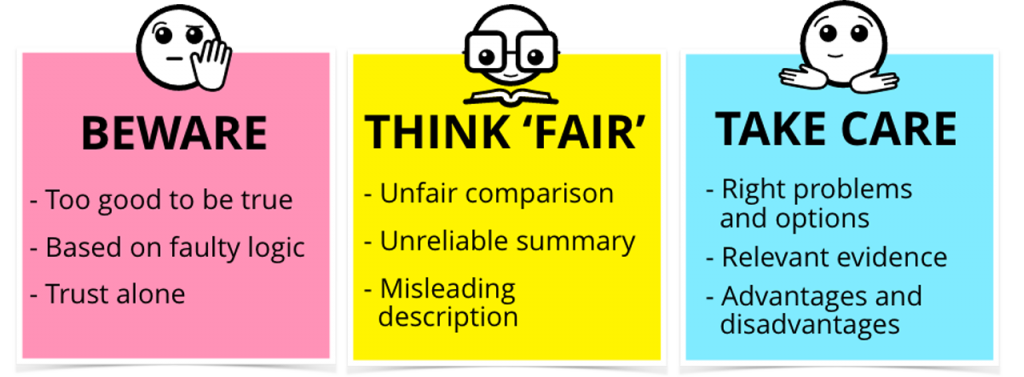Introduction
What kind of intervention should you be thinking about giving as a speech and language therapist? There are lots of claims about what you should and should not do and it’s important to cast a critical eye over them. What’s more, is not only do you need to understand the evidence behind claims, obviously you will need to ask about and factor in your service user’s and their families preferences before you make any decisions.
For example, there are claims that: modified diets help people with swallowing problems to eat by reducing a person’s risk of aspiration. But, also: that they can be harmful, and they may not improve quality of life for people with an unsafe swallow. How can you know which of these claims are trustworthy? And how should you decide when to carry out interventions with claims like these, or other claims about what is good or bad therapy? And what would the service user prefer?
A speech and language therapy “intervention” can be anything to do with helping someone’s speech, language, communication or swallowing difficulty- for example, recommending thickened fluids, running social skills programmes or giving a child speech sound activities to practice. An effect is something an intervention makes happen—like making a patient less likely to choke, helping a child to speak with friends or make their speech clearer.
A claim is something someone says that could be right, but it could also be wrong. The media, speech and language therapists, other professionals and people who’ve had speech and language therapy sometimes make claims about the effects of specific interventions. How can we tell which claims are right or wrong? To do this, you need to look at what supports their claim. For example, one parent’s personal experience of their child’s unintelligible speech miraculously becoming clear, following a particular kind of speech therapy, is not a good basis for a claim about what is good for all children. This is because we don’t know what would have happened if their child had received another kind of intervention or done something else, and we can’t be sure another child would respond in the same way. However, it is important that their perspectives are taken into consideration, and discussions should be held that explore all of these.
To know if an intervention (like minimal pairs ) causes an effect (like more intelligible speech), the approach has to be compared to something else (like multiple opposition therapy). Researchers should compare one intervention given to people in one group with something else given to people in another group. Those comparisons provide evidence – facts to support a conclusion about whether a claim is right or wrong. For those comparisons to be fair, the only important difference between the groups should be the kind of intervention they receive.
A good choice is one that uses the best evidence available at the time, appraised using your clinical expertise, and taking into account the preferred choice of the service user. Good choices don’t guarantee good outcomes, but they make good outcomes more likely. To do this, speech and language therapists need to be aware of key concepts to consider when evaluating claims.

Beware: Claims about the effects of interventions are not always trustworthy. Often this is because the basis for the claim is not trustworthy. The first (pink) group of guides are things you should watch out for when you hear or read a claim about an intervention programme or therapy approach.
Think fair: It is always a good idea to question what evidence there is to support a claim. Evidence about the effects of interventions comes from interventions comparisons. The second (yellow) group of guides can help you decide how trustworthy that evidence is.
Take care: Knowing how trustworthy the evidence is can help you make good choices about what kind of speech and language therapy you give. But there are other things you need to think about when you decide what to do and what not to do for your patients/clients. The third (blue) group of guides can help you make good choices.
Using the guides
There are lots of claims about different kinds of speech and language therapy approaches.
Some of these claims are true and some are false. Many are not supported by trustworthy evidence: we do not know whether they are true or false, and often in speech and language therapy we need more, and better quality research studies to be able to really decide this. Claims about the effects of different speech and language therapy interventions that are not supported by trustworthy evidence often turn out to be wrong.
Consequently, therapists who believe and base their therapy on these claims risk wasting our often-limited time by giving therapy which does not help, and by not doing things that do help.
These guides can be used to remind you of the key aspects to look out for when claims are made about speech and language therapy interventions.
This is all part of ensuring you are being an evidence-based speech and language therapist. Intervention choices should be made based on the actual evidence (not the ‘claim’), while employing your clinical expertise and taking into account the views of your patient/client and their parents and families. These guides should help you to think critically about what you hear or read about different interventions, and make sure you make evidence-based clinical decisions.